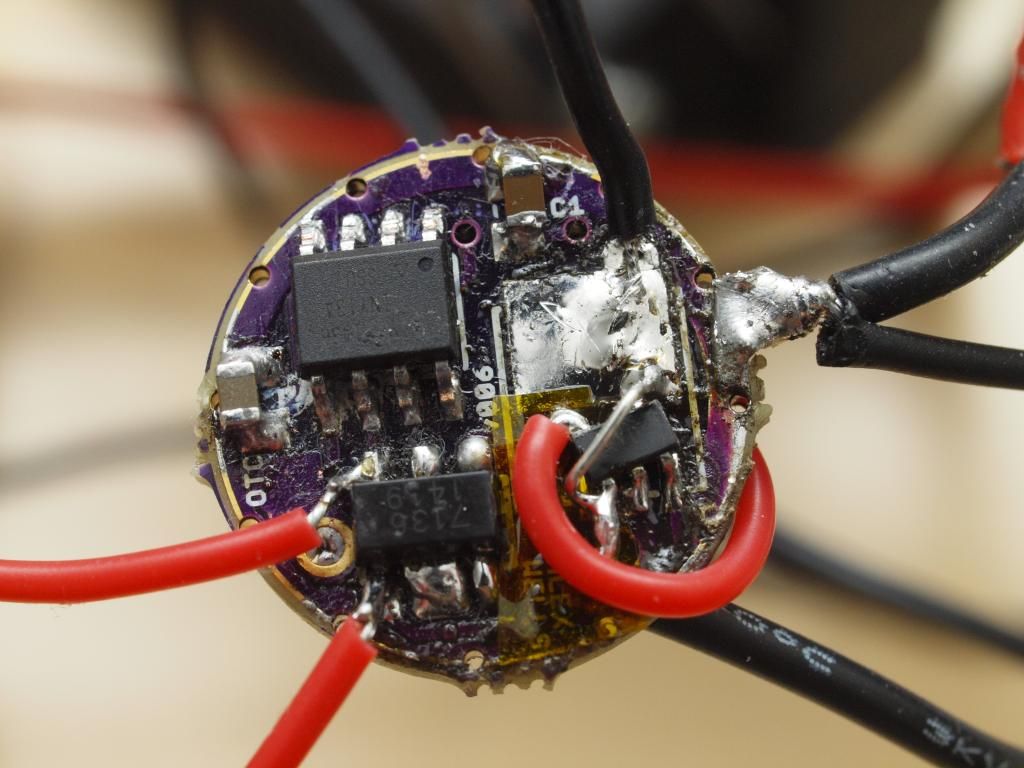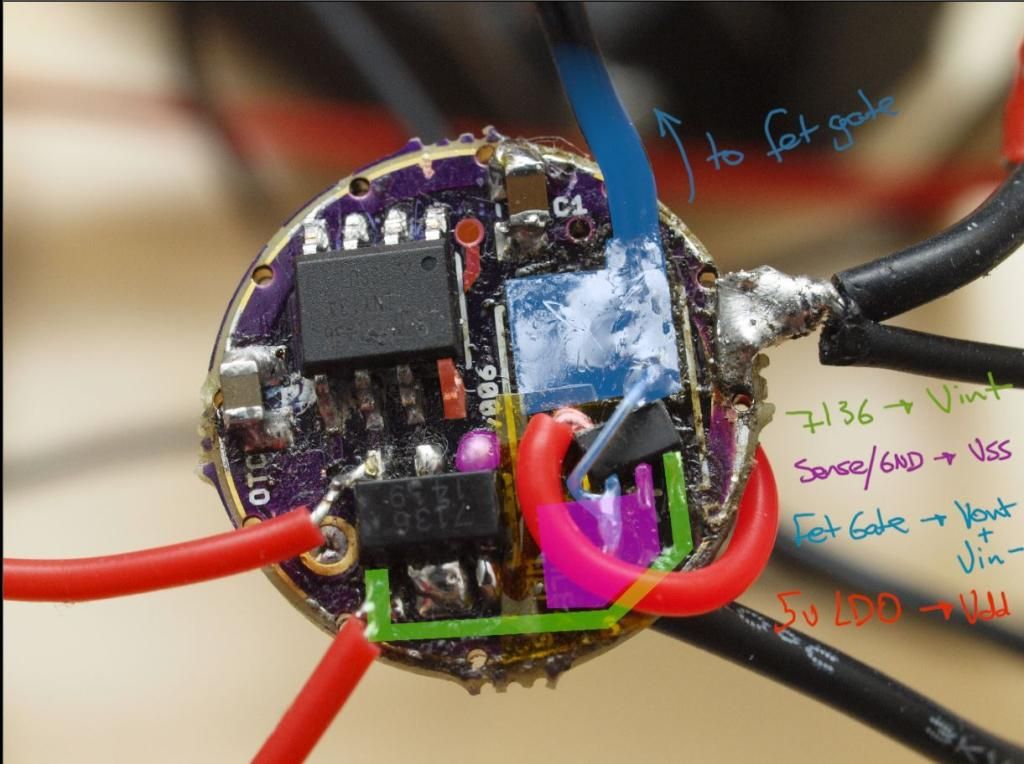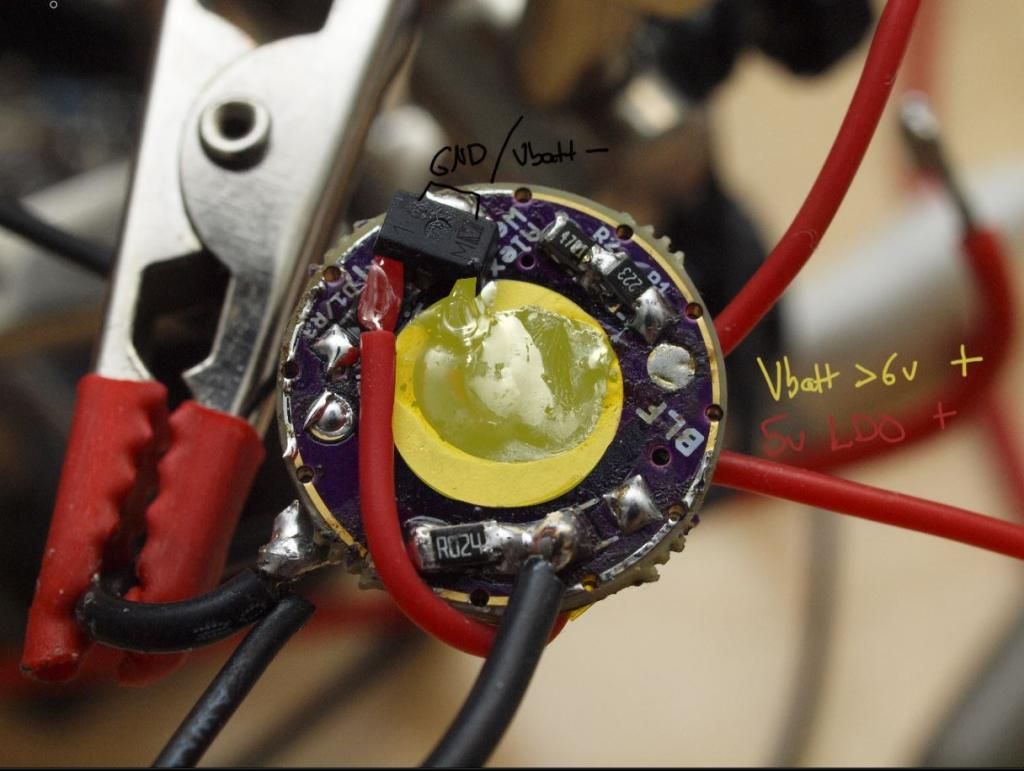Thanks dthoang, I’ll look into it! That sounds legit.
Alrighty so I’ve done a bit more tinkering and I have a version of this driver operational that fits my needs quite well.
Thought I’d outline the parts and setup in case anyone else sees a use for this driver similar to mine.
And no this won’t work particularly well if you just want to install the 17mm driver into a flashlight. You could probably still stick the opamp in there somewhere but my method here relies on having external fets.
—
Oh and Wight you may want to look away, because I’ve done terrible, nasty things to your beautifully designed board…there’s even some stacking involved! ![]()
![]()
My requirements where something like this…
-It needed to work visually flicker free with at least 4.7khz pwm and have a usable mode range. 1khz pwm flicker does my head in.
(This works great at 4.7khz and moonmode is now around 20pwm with this setup, it will also work at the standard Phase correct 9.5khz but with a more compressed mode range)
-Had to be able to drive a number of externally mounted mosfets. Also had to work with many fets not just the elusive DTU30N02
(All my tested fets work pretty good with this setup, those with lower threshold voltages still start up faster than others but all are now perfectly usable at 4.7khz)
-Had to run off a 5v LDO supply for >6v 2s input
So I used an Op-amp, specifically the MCP6001 as a unity gain buffer (a different op-amp than before but functionally similar to what I tested above). I don’t know too much about op-amps yet but I tested a few and this one worked very well and was available in a small enough form factor (sot-23).
Not much ringing or oscillations either, looks pretty clean on the scope.
Again not entirely sure why the 7136 behaves this way but it looks to me like using the op-amp as a signal buffer tricks the 7136 into ramping up it’s “soft-start” output much quicker than with a fet directly attached. This allows the driver to work fine with far more mosfets at higher PWM frequencies.
I’m not going to question too much how it works, but I do know it works rather well. ![]()
-
I used the tiny SOT-23 package version of the op-amp and installed it thusly.

Inch thick layer of flux residue and carpet fluff, probably optional… but you never know 
And some overlays showing how everything is wired up.

And the back showing the 5v LDO location.

It’s really messy but it works a treat. ![]()
Cheers
Heh, that’s a lot of work in order to use this thing LinusHofmann. Thank you (and pilotdog68) for being guinea pigs on this driver, and thank you for all the work you did analyzing it’s behavior.
Good work nonetheless, and I’m glad you’ve got it into a state that may help you!
I’ve marked the thread title with [retired], the driver is not really workable as-is IMO.
To each his own I guess. I like it in my L5, and I prefer it over stacking a bunch of chips.
Yeah it’s a shame it didn’t work in it’s standard form. I hope you return to design another linear mosfet driver at some point though. I think there’s a niche for a low part count simple linear regulator with DD bypass, just based around something less touchy than that 7136 ![]()
For me, with this workaround it works more than well enough to fill that niche. And I certainly learned a lot testing this driver! So thanks for putting it out there.
Cheers
You’re welcome. I’m glad you both got something useful out of it, and I’m certainly not pulling the files. People can continue to build them if they’d like!
I’m sure I’ll take another look at an FET linear driver, but the parts count will certainly go up. An op-amp based solution will require quite a few components: we’ll lose the 7136, but add an op-amp. In addition we’ll have an RC circuit (so two additional passive components, resistor and capacitor) in order to generate an analog output from the MCU. That analog output will be variable unless we use a Zener or LDO. I suppose we can stick with a Zener and see how it works, a 2v or 2.5v Zener should allow the MCU to maintain consistent analog output down to a very low battery level even with only 1s.
Offhand I think that the falling MCU voltage w/out this solution would cause output levels to drop as battery voltage drops (in a 1s config).
The 17mm board was already pretty tight without two more 0805’s. I don’t think it will all fit with the big spring pad. It might not all fit even with a little spring pad and 0603 sized components.
This is not something I intend to attack immediately.
Thank you for all of your hard work on this.
I'm going more and more to FET drivers for anything over 4A with a XM-L2. The newer ones won't pull much over 5A anyways with the best cells, and with average cells only around 3.5A-4A, so really a 5A linear driver is pretty useless now for an XM-L2. I would say that hopefully they would be useful for the triples, etc., but the led4power driver overheats when used with a triple so I suspect that something like this would as well. I see the merit for the 6V LEDs, but again I wonder if heat will end up being a major issue.
I should note, however for all of the newer guys, that a true constant current driver does have some benefits. No PWM (although the 7136 is sort of a hybrid in this regard) and more efficient at lower drive levels. That said, these aren't benefits that most looking for a 5A flashlight really will notice or care about.
It is amazing to see just how much the vF has gone up. It is really evident now that I have my big power supply and can easily measure the vF of different LEDs. The XM-L is quite a bit lower than any XM-L2, but the newer XM-L2s are definitely higher than the older ones. They can't handle as much current either, with a lot of them having a hard time reaching or breaking the 6A mark. That said, the U3s at 5A are pretty dang close to a U2 at 6A, so efficiency has been improved. I wish that we could have had the increased efficiency while retaining the lower vF. The newer XM-L2s of every bin seem to have a higher vF than the older ones, so it's not just the U3s.